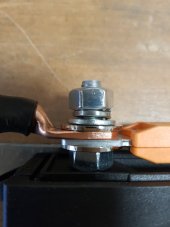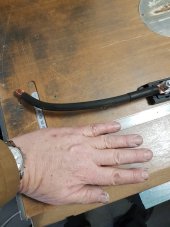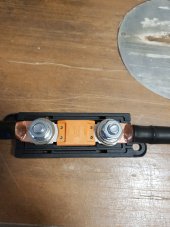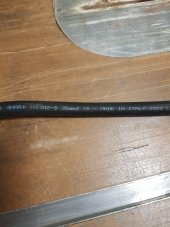BackTOschool
tellsteve2@gmail.com
- Joined
- Sep 29, 2022
- Messages
- 44
Hello,
Can I ask for advice please?
I have a heating issue that I do not understand, My positive lead to the inverter is going above > 50deg c. (and would go higher if left)
I have 1 x 300Amp battery, with a 12v1200 watt Victron inverter.
When the inverter is near load max output at 1130 watts, I'm finding that my positive lead connecting the battery to the inverter is getting hot between the battery and fuse.
I previously used 25mm pure copper multistrand welders cable, which I have replaced with 35mm cable, my understanding it's rated to 290Amps.
I previously used a cheap Amazon ANL 125A fuse, which I've upgraded with a Victron Energy Mega Fuse Holder and a Mega Link Fuses Current Rating: 150A
The constant test load is 106A (240v) ( 1130 watts )
The Battery is good for a consistent load of <150A
The Cable is good for < 290 Amps, and has been created with recommended pure copper lugs.
Even after the "uprating" Its still getting hot, > 45+ deg C
I have now completely removed the fuse by making a new cable straight from battery to inverter (yes I know that's not recommended) and the heat disappears!
Any idea's please?
thanks
Steve.
Can I ask for advice please?
I have a heating issue that I do not understand, My positive lead to the inverter is going above > 50deg c. (and would go higher if left)
I have 1 x 300Amp battery, with a 12v1200 watt Victron inverter.
When the inverter is near load max output at 1130 watts, I'm finding that my positive lead connecting the battery to the inverter is getting hot between the battery and fuse.
I previously used 25mm pure copper multistrand welders cable, which I have replaced with 35mm cable, my understanding it's rated to 290Amps.
I previously used a cheap Amazon ANL 125A fuse, which I've upgraded with a Victron Energy Mega Fuse Holder and a Mega Link Fuses Current Rating: 150A
The constant test load is 106A (240v) ( 1130 watts )
The Battery is good for a consistent load of <150A
The Cable is good for < 290 Amps, and has been created with recommended pure copper lugs.
Even after the "uprating" Its still getting hot, > 45+ deg C
I have now completely removed the fuse by making a new cable straight from battery to inverter (yes I know that's not recommended) and the heat disappears!
Any idea's please?
thanks
Steve.









